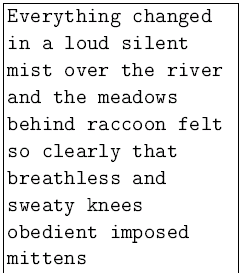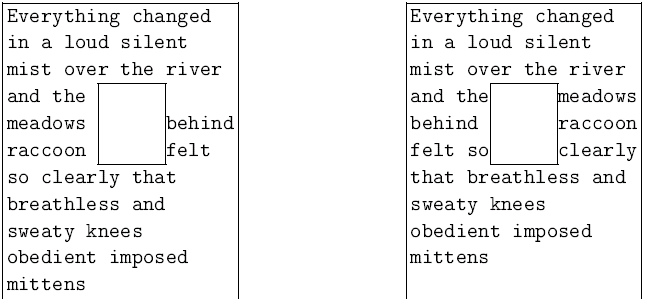| acmsguru |
|---|
| Finished |
→ Problem tags
No tags yet
No tag edit access
The problem statement has recently been changed. View the changes.
×
494. Journal
Time limit per test: 0.25 second(s)
Memory limit: 262144 kilobytes
Memory limit: 262144 kilobytes
input: standard
output: standard
output: standard
There's an article of N words, with the i-th word consisting of Li letters. The article has to be printed in a journal on a page W characters wide (for simplicity, let's assume that the page can contain as many lines as necessary and that all characters have the same width). The algorithm of laying out the text on the page of the journal is as follows. The words are placed in order: 1-st, 2-nd, ·s, N-th. The location for the i-th word is determined by the following rules:

In addition to the article, an illustration has to be placed on the page. The illustration takes up a rectangular area R rows high and C columns wide. The illustration is placed on the page before the text is laid out and it may be placed anywhere on the page. After the illustration is placed, all character positions covered by it are considered occupied and then the text is laid out according to the algorithm described above.
A row on the page is considered used if, after the illustration is placed and the text laid out, at least one character of the row is occupied. The total number of rows used may depend on the position of the illustration. For example, two possible final layouts of the illustration and the text are shown below, with one using 11 and the other 10 rows:

Given the dimensions of the illustration and a description of the text, place the illustration in a way that minimizes the number of rows occupied by the final layout.
Input
The input file contains several test cases. The first line of the file contains T ( ), the number of test cases. Descriptions of the T test cases follow.
), the number of test cases. Descriptions of the T test cases follow.The description of each test case starts with the integers N, W, R, C (
 ,
,  , 1 ≤ C ≤ W), followed by the description of the text of the article as N integers L1, L2, ·s, LN (1 ≤ Li ≤ W). The numbers may be separated by spaces and/or newlines.
, 1 ≤ C ≤ W), followed by the description of the text of the article as N integers L1, L2, ·s, LN (1 ≤ Li ≤ W). The numbers may be separated by spaces and/or newlines.It may be assumed that the sum of values of N over all test cases in the file does not exceed
 .
.Output
For each test case, output a single line containing the minimal number of rows needed to lay out the article.Example(s)
sample input | sample output |
1 26 20 3 6 10 7 2 1 4 6 4 4 3 5 3 3 7 6 7 4 2 7 4 10 3 6 5 8 7 7 | 10 |
Codeforces (c) Copyright 2010-2024 Mike Mirzayanov
The only programming contests Web 2.0 platform
Server time: Apr/18/2024 22:25:50 (h2).
Desktop version, switch to mobile version.
Supported by
User lists


| Name |
|---|




